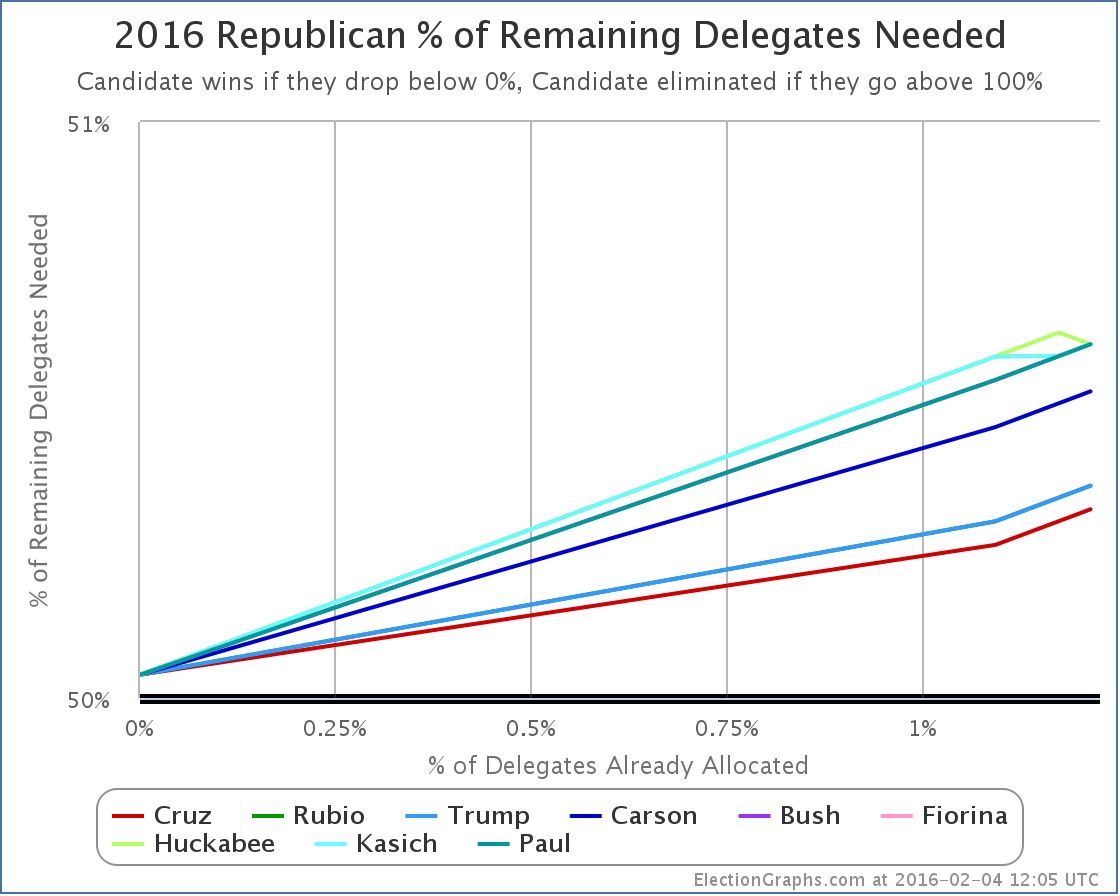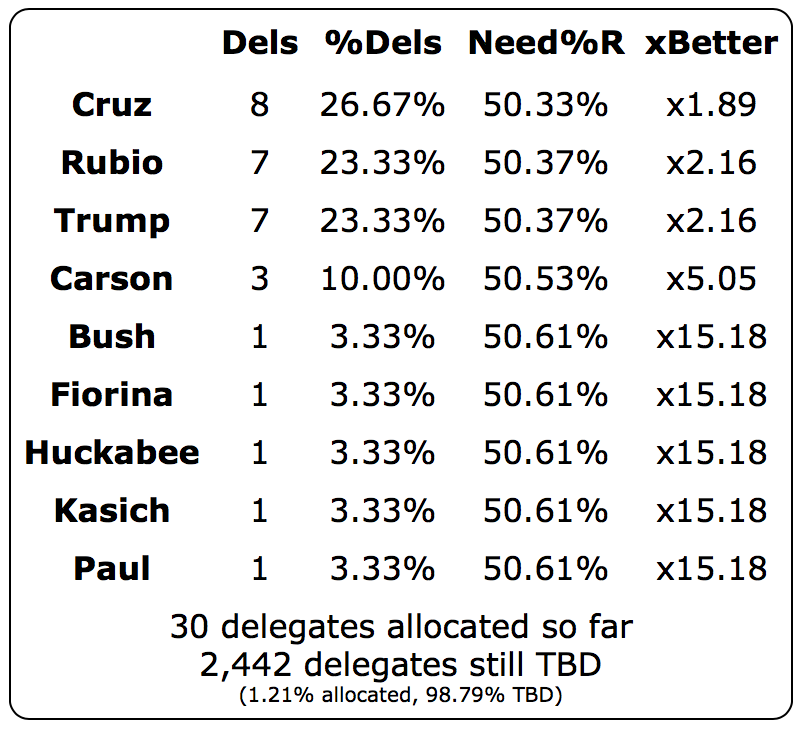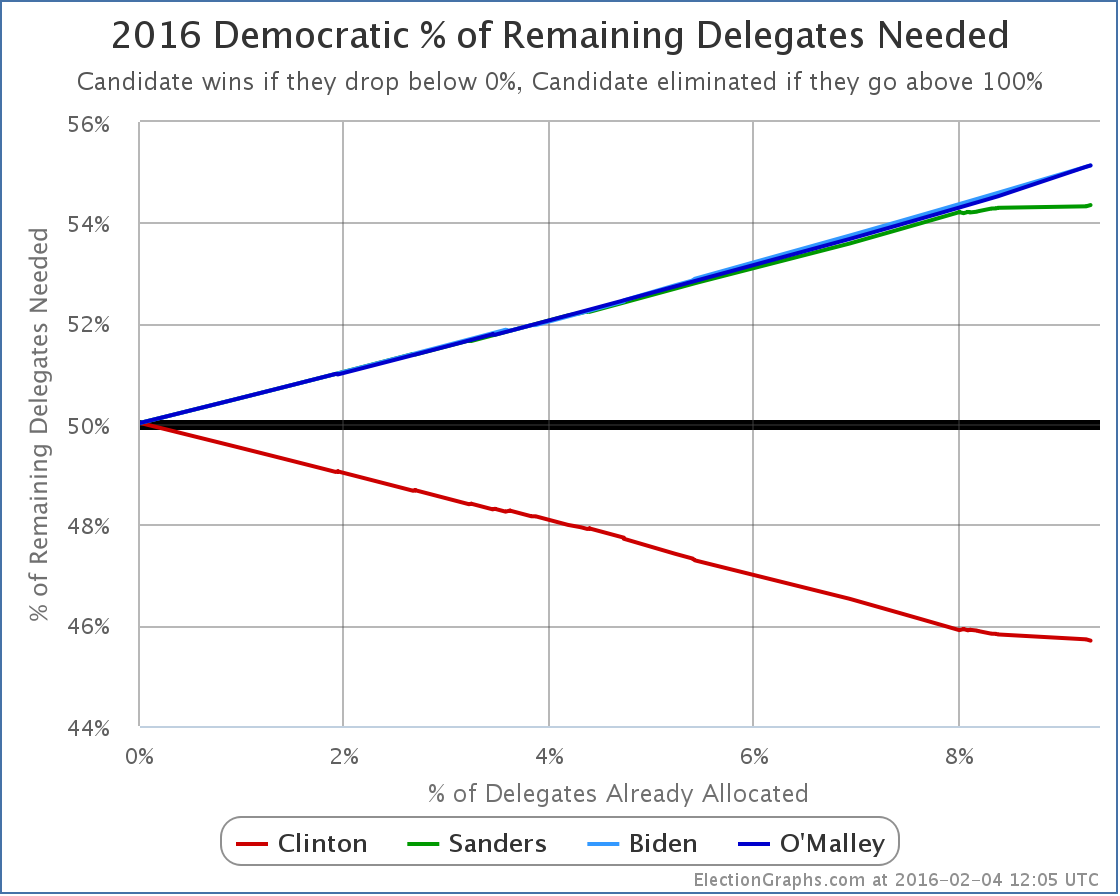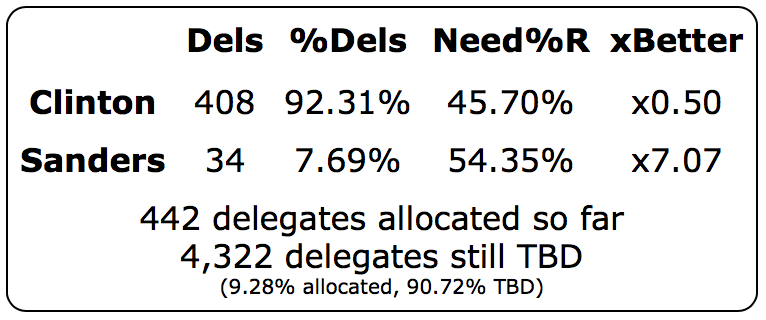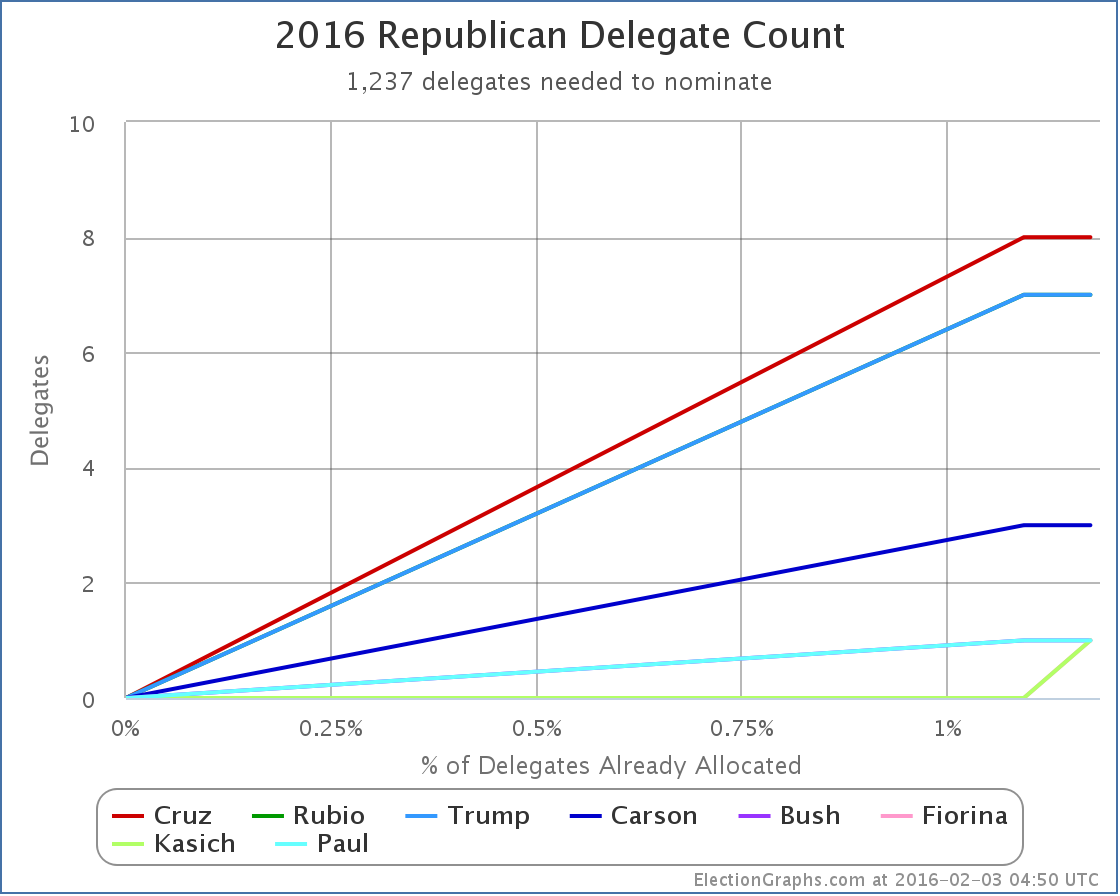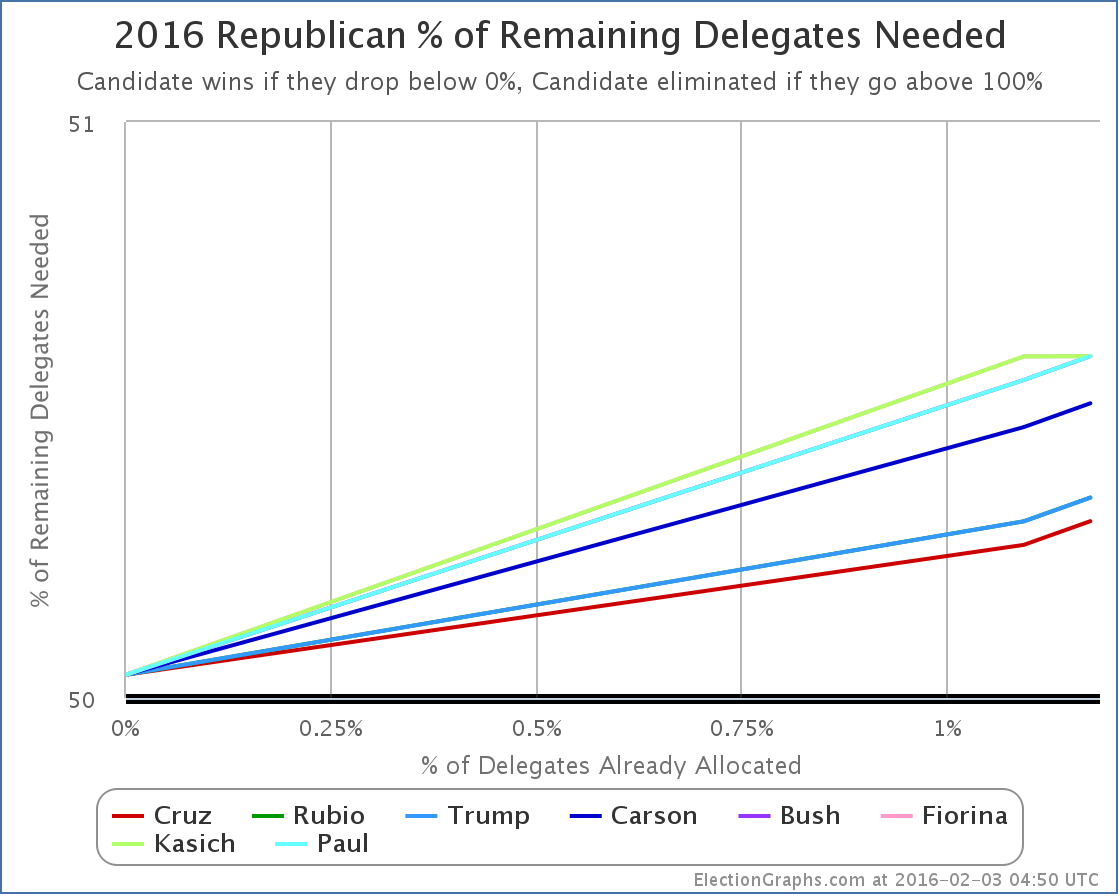- 11:42:05 New Curmudgeon’s Corner podcast is out. We start talking about Election 2016 six minutes in, and go for 96 minutes. https://t.co/234mZMBO9l
- 12:41:57 [Blog post] Democrats: Some Superdelegate Updates https://t.co/C12IMM3C9u
- 13:46:22 [Blog post] Republicans: Iowa results officially certified, Huckabee gets a delegate too! https://t.co/mkE7laaFns
The Iowa results on the Republican side were officially certified on Wednesday, earlier than anybody expected, and with a surprise. Almost every source believed 27 delegates would be decided by the caucus results, but the remaining 3 “automatic delegates” who are party leaders, would attend the convention unbound and able to support whoever they wished. But it looks like those three delegates will be bound by the caucus results as well. When you do the required math on 30 delegates instead of 27, everything remains the same, except Huckabee gets a delegate too. Updating the chart showing the “% of remaining needed to win” graph: And the raw numbers: Huckabee and Paul have suspended their campaigns, but since these are bound delegates, they keep them unless the candidates officially release them. I haven’t seen a report of that yet, so won’t remove them from the list at this point. Not that it matters much for single delegates. This is a much more important factor when candidates drop out later in the race once they have already accumulated a significantly sized chunk of delegates. Huckabee’s one delegate makes no difference to the analysis I posted Tuesday or the follow up from Wednesday. We still have three candidates showing strength going into New Hampshire It is within the realm of possibility that New Hampshire will add a fourth to that list, but just as likely it will solidify the “three way race” picture. And as I outlined in the Wednesday post the specific New Hampshire delegate rules matter a lot. Specifically the rules essentially give extra bonus delegates to the winner, and don’t allow delegates at all for anyone coming in under 10%. This is a recipe to transform a plurality win to a healthy delegate majority. So if you are watching the polls as they start to include post-Iowa data, watch carefully not only who is in the lead, but exactly who is above or below the 10% threshold, because that will make a huge difference in the delegate counts. And an 8-7-7 split with only 1.21% of delegates determined is essentially a tie. And a tie that will soon be overwhelmed numerically by the results from New Hampshire and beyond. So don’t get sucked too deeply into the spin from all quarters taking about who is up and who is doomed. It is still too early for that. (Well, at least if you don’t drop out.) Five days until New Hampshire. Note: This post is an update based on the data on ElectionGraphs.com. Election Graphs tracks both a poll based estimate of the Electoral College and a numbers based look at the Delegate Races. All of the charts and graphs seen in this post are from that site. Additional graphs, charts and raw data can be found there. All charts above are clickable to go to the current version of the detail page the chart is from, which may contain more up to date information than the snapshots on this page, which were current as of the time of this post. Follow @ElectionGraphs on Twitter or like Election Graphs on Facebook to see announcements of updates or to join the conversation. For those interested in individual general election poll updates, follow @ElecCollPolls on Twitter for all the polls as they are added. I’ve promised not to post every day there is an update of a superdelegate here or there. Instead, I’ll generally include them in the next post after an actual primary or caucus. However, if enough accumulate, I’ll go ahead and do a post just on superdelegates. There have been 10 superdelegate changes since my last post on the Democrats. That’s as good a threshold as any, so here is a quick update. First of all, I probably should have made this change before that last post, but I didn’t… O’Malley dropped out on caucus night shortly after the results started coming in, as it was immediately clear that as expected he would not have a good night. If O’Malley had earned actual pledged delegates, they would remain in his column until such time as O’Malley formally released them. But these superdelegates are always free agents, and with O’Malley out, there is no reason to believe their previous endorsements of O’Malley still stand. So I zeroed out O’Malley’s three superdelegates. Goodbye O’Malley. In addition, news reports showed 5 new Clinton superdelegates in Illinois, and 2 new Clinton superdelegates in Iowa. So, net Change: Clinton +7, O’Malley -3. New “% of remaining needed to win chart”: And the updated data chart: As of my post-Iowa summary post, Sanders needed 54.30% of the remaining delegates to catch up. That is now up to 54.36%. In terms of New Hampshire specifically, this doesn’t matter of course. Either way Sanders needs 14 of the 24 delegates that will be allocated based on the primary in order to be on a pace to catch Clinton. Five days until New Hampshire. Note: This post is an update based on the data on ElectionGraphs.com. Election Graphs tracks both a poll based estimate of the Electoral College and a numbers based look at the Delegate Races. All of the charts and graphs seen in this post are from that site. Additional graphs, charts and raw data can be found there. All charts above are clickable to go to the current version of the detail page the chart is from, which may contain more up to date information than the snapshots on this page, which were current as of the time of this post. Follow @ElectionGraphs on Twitter or like Election Graphs on Facebook to see announcements of updates or to join the conversation. For those interested in individual general election poll updates, follow @ElecCollPolls on Twitter for all the polls as they are added. We made it past Iowa! We have Iowa results! We have brand new speculation about New Hampshire and beyond! Yes, of course, the bulk of this week’s Curmudgeon’s Corner podcast is Sam and Ivan discussing where the presidential race sits in this week between Iowa and New Hampshire. We go over all of the results so far, then discuss how candidates, the media and the public are reacting to those results, and what that means for the rest of the contest. Plus, for the first time in a little while, we do a lightning round as well, covering bluetooth audio issues, Iran, the Flint water crisis, tech earnings results, and more! Click below to listen or subscribe… then let us know your own thoughts! Length this week – 2:12:09
Show Details:
Yesterday’s update was preliminary, and I ended up using the delegate estimates provided by the AP which were used at the New York Times, Washington Post, and other places. My favorite source, Green Papers, had a different set of numbers. When I tried to calculate delegate numbers myself, I came up with yet another set of numbers. I ended up going with the AP numbers. A little more than a day later and Green Papers updated, now matching what I had calculated myself. So I’m updating the estimates accordingly. This moves us from: 8 Cruz, 7 Trump, 7 Rubio, 3 Carson, 1 Bush, 1 Paul to 7 Cruz, 7 Trump, 6 Rubio, 3 Carson, 1 Bush, 1 Fiorina, 1 Kasich, 1 Paul. The main change here is one less delegate each to Cruz and Rubio, with those delegates picked up at the bottom end by Fiorina and Kasich. But wait! There is more! The Washington Post and Politico both add two additional delegates. The 27 allocated by the caucus results were already accounted for, so these would be two of the three “party leaders” who end up as automatic delegates. No indication of which party leader did what, but they add one additional delegate each to Cruz and Rubio. The new Iowa totals become: 8 Cruz, 7 Rubio, 7 Trump, 3 Carson, 1 Bush, 1 Fiorina, 1 Kasich, 1 Paul. Between these two changes, the net is simply adding the delegates for Fiorina and Kasich. This means 29 of the 30 Iowa delegates are now accounted for. Note that even though Paul has “suspended his campaign”, he keeps his delegate unless he explicitly releases it. The raw delegate count chart now looks like this: Just a little uptick at the end for Fiorina and Kasich to join Bush and Paul at the 1 delegate mark. Flipping this over to look at “% of remaining needed to win”: On this chart, lower is better. When you get down to 0% you win. If you get to 100% you are eliminated. Everybody is still heading upward, not downward, but it is still very early. The whole field here ranges from needing 50.31% of the remaining delegates, to needing 50.59% of the remaining delegates. Looking specifically at New Hampshire, there are 20 delegates at stake. We are so early, and the % needed numbers so close, that this is easy. The number needed to be on track to win is 11 delegates. Anything less, and the candidate is actually going to be in a harder position in the next contest rather than an easier one. Let’s game out New Hampshire based on the current RCP averages. Yes, yes, this is based on polling before New Hampshire. Things will change in the next six days. But this is just to model how it works. The rules via The Green Papers:
Assume each candidate gets exactly their poll average today. Only the candidates over 10% matter, so with RCP as of right now that is: 33.4% Trump, 12.2% Cruz, 10.8% Rubio, 10.4% Kasich Converting this to delegates with the rounding rules above, you get: 7 Trump, 2 Cruz, 2 Kasich, 2 Rubio This is only 13, so there are 7 delegates left. According to the last rule, these all go to the leader, so we end up with: 14 Trump, 2 Cruz, 2 Kasich, 2 Rubio And therefore Trump would get 70% of the delegates despite only getting 33.7% of the vote. Trump’s line on the “% needed to win” would go down, while everybody else would go up. After this hypothetical New Hampshire result, the overall race would be: 21 Trump, 10 Cruz, 9 Rubio, 3 Carson, 3 Kasich, 1 Bush, 1 Paul, 1 Fiorina. Trump would still only have 42.9% of the delegates, which is not a majority, but Cruz would be way back at 20.4% and you’d have Trump starting to pull away from the pack. Still only 1.98% of delegates allocated at that point though, with lots of room for further changes. The RCP average on February 3rd is NOT going to look like the actual results on Primary night. This is just an example. The points to take away:
Of course New Hampshire will be here soon enough, and we’ll do this with the real results. Note: This post is an update based on the data on ElectionGraphs.com. Election Graphs tracks both a poll based estimate of the Electoral College and a numbers based look at the Delegate Races. All of the charts and graphs seen in this post are from that site. Additional graphs, charts and raw data can be found there. All charts above are clickable to go to the current version of the detail page the chart is from, which may contain more up to date information than the snapshots on this page, which were current as of the time of this post. Follow @ElectionGraphs on Twitter or like Election Graphs on Facebook to see announcements of updates or to join the conversation. For those interested in individual general election poll updates, follow @ElecCollPolls on Twitter for all the polls as they are added.
|
||
